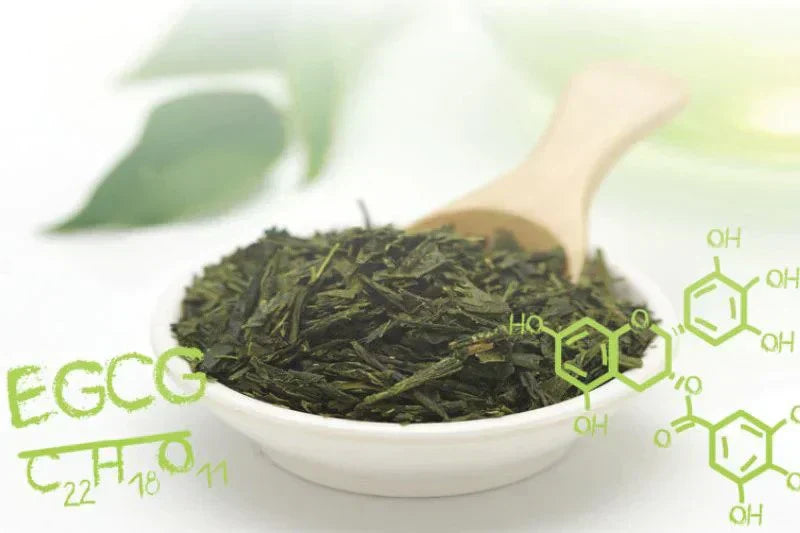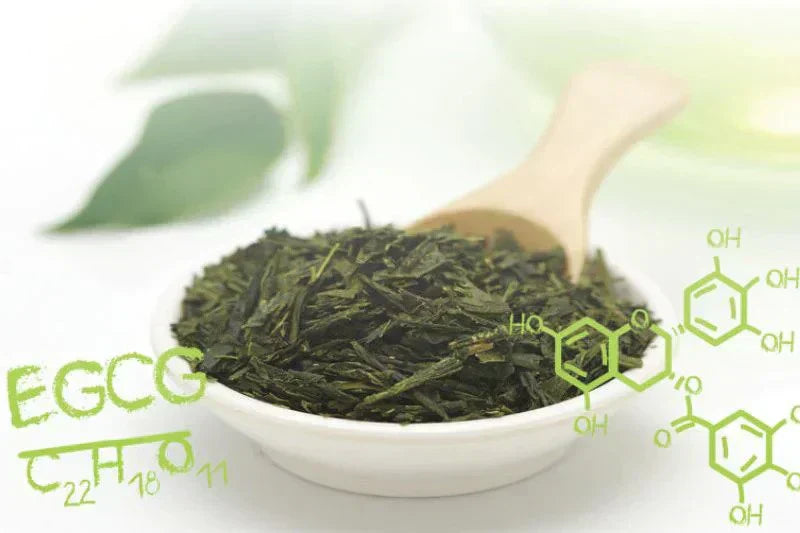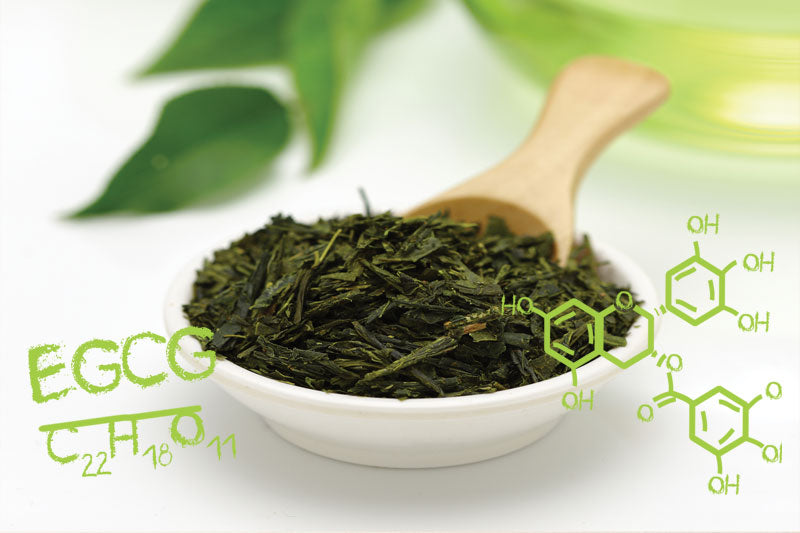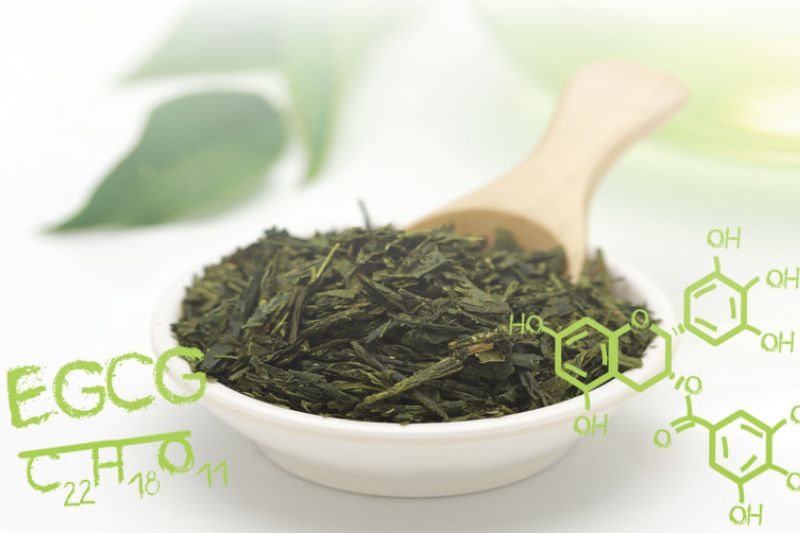Welcome to Part Five of the Green Tea Science series! This article will answer 10 Commonly Asked Questions and explain how you can benefit. We're going to cover important topics relating to commonly asked questions about green tea benefits.
10 Commonly Asked Questions and How You Can Benefit
If you have not yet read the first two posts in this series, you can find them here:
Part 1: Polyphenols, Catechines and EGCG
Part 2: Tannin, Gallic Acid
Part 3: Caffeine
Part 4: Vitamins
- What are catechins?
- What is methylation?
- What are methylated catechins?
- What other foods have methylated catechins?
- How do the catechins in green tea compare to those in other foods?
- Can methylated catechins help allergy sufferers?
- Can methylated catechins help those with obesity?
- Do methylated catechins have adverse side effects?
- Which tea has the highest methylated catechin content?
- Identified as the tea cultivar with the most methylated catechins, what benefits does Benifuuki Green Tea offer?
1. What are catechins?
Catechin is a kind of antioxidant that is most commonly associated with tea. It helps defend cells from free radicals. These are unstable molecules that can build up in cells, causing damage to other molecules. They are created during regular cell metabolism, which refers to chemical changes in a cell. Free radicals are said to raise the risk of cancer as well as other diseases. This is why catechins are being further studied in relation to their possible contribution not only to the treatment of cancer but to its prevention as well.

2. What is methylation?
Methylation refers to a biochemical process that involves the transfer of CH3 (one carbon atom and three hydrogen atoms) from one substance to another. In the human body, the occurrence of methylation significantly benefits various biochemical reactions that regulate different functions, including cardiovascular, neurological, reproductive, and detoxification systems. It also positively impacts DNA production, neurotransmitter production, eye health, liver health, cellular energy, histamine metabolism, estrogen metabolism, and fat metabolism.


3. What are methylated catechins?
As mentioned, catechins are the main set of tea flavonoids that act as antioxidants. Most of them are epicatechin (EC), epigallocatechin (EGC), epicatechin gallate (ECG), and epigallocatechin gallate (EGCG). Their chemical structures give a clue as to their biological activities. They are quickly metabolized, which also brings forth chemical modifications. The second-phase metabolism of catechins involves O-methylation and sulfation by enzymes that include catechol-O-methyltransferase (COMT), among other changes. The metabolites formed here, such as methylated catechins, have immensely beneficial biological activities. This is why they have an even stronger potential for the prevention and treatment of diseases, including diabetes, cancer, colitis, etc.
4. What other foods have methylated catechins?
While catechins are predominantly found in tea, particularly green tea, they are also present in fruits, vegetables, herbs, algae, and confectionary items. For instance, you can source them from chocolate; fruits like cranberries, blackberries, strawberries, cherries, apples, pears, peaches, kiwis, and avocados; as well as nuts like hazelnuts, pecans, and pistachios. They also exist in beverages like red wine, beer, cacao liquor, and cocoa.
These are plain catechins, however. Methylated catechins as an active ingredient, on the other hand, are mainly associated with green tea. Nonetheless, studies indicate that catechins, upon consumption, are methylated in plasma. At different points in their journey, catechins present themselves as metabolites, which are perceived to be the active forms of flavonoids as protective nutrients. Therefore, they are more abundant in plasma, where a percentage of them also becomes methylated.


5. How do the catechins in green tea compare to those in other foods?
As far as methylated catechins are concerned, green tea is the only source generally cited. However, it has also been reported that epigallocatechin 3-O-(3-O-methyl) gallate is a natural product present in Limonium Sinense, the more familiar names of which are statice and sea lavender. While this plant is non-toxic to humans, it’s more known as an ornamental than an herbal or culinary plant. Officially, though, this methylated catechin, the name of which is shortened to EGCG"Me, only exists abundantly in a few tea plants.
When it comes to catechins in general, tea is identified as the primary source, but even in green tea products themselves, the catechin content could be highly variable. As previously indicated, there are a wide variety of foods from which catechins can be derived. Green tea offers the highest possible EGCG (the most pharmacologically potent catechin) content, with 10–80 mg per hundred grams. In comparison, apples provide 10–43 and cherries, 5–22.
6. Can methylated catechins help allergy sufferers?
According to studies, two methylated catechins, epigallocatechin-3-O-(3-O-methyl) gallate and epigallocatechin-3-O-(4-O-methyl) gallate, can help with allergic reactions more than the non-methylated EGCG forms. They do this by inhibiting the mast cell response. Mast cells have an essential role in immediate reactions pertinent to hypersensitivity and allergies. Their activation leads to histamine and leukotriene (chemicals from the body that cause extra mucus, coughing, inflammation, etc.) release, as well as cytokine production and secretion. Cytokines are secreted proteins that play an important role in the inflammatory process, having a special effect on the communication and interactions between cells.

Acknowledging the effectiveness of methylated catechins against allergic responses, experts suggest that allergy sufferers consume 34 mg of these in tea daily, starting about a month and a half before pollen season, to optimally experience their anti-allergy benefits.

7. Can methylated catechins help those with obesity?
Obesity is a very real problem across the world. Meanwhile, there’s a prevailing impression that green tea can help reduce weight. This effect can be put down to two components in green tea: caffeine and catechin. The latter can help break down excess fat, while both can boost the amount of energy used by the body.
Since obesity is a metabolic disturbance that results from a lack of balance between lipogenesis (fat synthesis) and oxidation (fat breakdown), research was done on the lipid-lowering effects of different green tea cultivars. According to studies, green tea cultivars that contained methylated catechins had even greater hypolipidemic activity and anti-obesity effects than cultivars that didn’t have methylated catechins. These resulted in the conclusion that the highly absorbent methylated catechins help prevent obesity brought about by diet-induced lipid metabolism disorders.
8. Do methylated catechins have adverse side effects?
The main issue with general catechin content in green tea is that high concentrations of the compounds could cause liver problems, but it has been concluded that catechins absorbed by the body from green tea infusions are safe as a rule. However, caution is issued to those taking supplements with green tea extract, as these could have higher concentrations of catechins that could potentially damage the liver. Therefore, it is advised that labels of food supplements be perused for the catechin dose. Anything that could lead to consumption of 800 mg or more per day may pose health risks.


9. Which tea has the highest methylated catechin content?
When it comes to methylated catechins, only a few green tea cultivars are known to contain them in considerable quantities. These are Benihomare, Benifuji, and Benifuuki. Among the three, Benifuuki is said to have the highest methylated catechin content. However, it has also been reported that a wild tea plant from Fujian, China, has naturally occurring high contents of 3’-methyl-epigallocatechin gallate (EGCG3"Me). This discovery is being further probed to see its potential value in the health industry.
10. Identified as the tea cultivar with the most methylated catechins, what benefits does Benifuuki Green Tea offer?
In 1965, tea masters decided to crossbreed Assamica with Sinensis and came up with a cultivar called Benifuuki. It was initially developed to make black tea, but it was soon discovered that by harvesting it as a green tea, they could produce a delightfully bitter and powerful health beverage, thanks to its high concentration of methylated catechins. The beneficial flavonoids are most abundant in the following:
- In the first crop, among mature leaves under the fourth shoot
- In the second crop, among the mature leaves under the third shoot
Benifuuki tea is reported to alleviate allergy symptoms, help with detoxification, boost metabolism, fight high blood pressure, and improve skin health. You can read a more in-depth discussion of its benefits here.
Get Free Bonus Books

Sign up for free to the Green Tea Club to get advice and exclusive articles about how to choose Japanese Tea, and tips, tricks, and recipes for enjoying Japanese tea.
About the author
Kei Nishida
Author, CEO Dream of Japan
Certification: PMP, BS in Computer Science
Education: Western Washington University
Kei Nishida is a passionate Japanese green tea connoisseur, writer, and the founder and CEO of Japanese Green Tea Co., a Dream of Japan Company.
Driven by a deep desire to share the rich flavors of his homeland, he established the only company that sources premium tea grown in nutrient-rich sugarcane soil—earning multiple Global Tea Champion awards.
Expanding his mission of introducing Japan’s finest to the world, Kei pioneered the launch of the first-ever Sumiyaki charcoal-roasted coffee through Japanese Coffee Co. He also brought the artistry of traditional Japanese craftsmanship to the global market by making katana-style handmade knives—crafted by a renowned katana maker—available outside Japan for the first time through Japanese Knife Co.
Kei’s journey continues as he uncovers and shares Japan’s hidden treasures with the world.
Learn more about Kei








